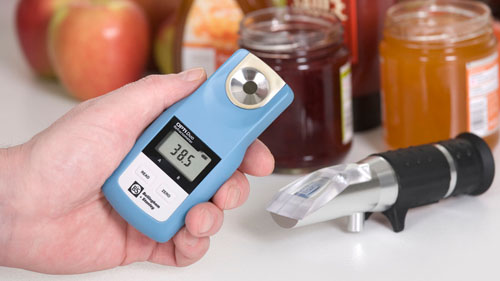18 Top Tips For Quality Refractometer Results part 4: Continuously achieve accurate results through maintenance
In the final part of our Refractometer Top Tips series we’ll be focusing on how you can continuously achieve accurate results through verification, calibration and general maintenance.
If you’ve missed the previous parts of this series you can you catch up through the links below:
Part 1 - Refractometers 101 & The need for Quality Control
Part 2 - Choosing the right refractometer
Part 3 - Sample preparation & taking a reading
If you're all caught up, then we shall continue with our 18 Top Tips For Quality Refractometer Results.
14. Treat handheld refractometers with care for continuously accurate results
 Optical and digital handheld refractometers require little maintenance, often only requiring a zero calibration with water. For high range instruments that don’t have a zero point, use a sugar sample or for optical instruments, a solid test plate. Some digital handheld refractometers also allow verification of the upper scale using a long-life, certified sample. You can purchase solid test plates, sugar solutions and long-life certified samples from reputable refractometer specialist stockists such as Refractometer Shop.com.
Optical and digital handheld refractometers require little maintenance, often only requiring a zero calibration with water. For high range instruments that don’t have a zero point, use a sugar sample or for optical instruments, a solid test plate. Some digital handheld refractometers also allow verification of the upper scale using a long-life, certified sample. You can purchase solid test plates, sugar solutions and long-life certified samples from reputable refractometer specialist stockists such as Refractometer Shop.com.
Always keep your refractometer clean. Remove all traces of sample from the prism once it has been read and keep your refractometer in a safe place; after all, a refractometer is a delicate, scientific instrument.
15. Consider installation and training as a start-up package
When purchasing your new refractometer consider installation and training as part of a new user start-up package. For regulated environments such as within the pharmaceutical industry, it is worth asking the instrument manufacturer, their local distributor or even an independent validation contractor to perform a validation (IQ/OQ/PQ) using traceable standards prior to use. Configuration and start-up training can then be done in one session saving time and money.
16. Verify refractometer performance regularly
Verify and if necessary calibrate the refractometer on a regular basis. Typically, a ZERO verification should be performed daily. SPAN, a validation of the upper part of the scale or in the range where you normally take measurements, should be done weekly and only after a ZERO validation. Always squeeze some sample to waste to ensure no crystals have formed in the nozzle.
Only adjust the refractometer if it falls out of specification and make sure samples are left long enough for the temperature to stabilise.
Clean and dry carefully between each verification and if in doubt of the reading, do it again to ensure you don’t calibrate in any erroneous readings! Always consult with the instrument instructions and the guidelines of the standard being used.
17. Schedule regular maintenance within your operating procedures
With busy work schedules it can be all too easy to forget or skip regular maintenance. Create and regiment a schedule within your operating procedures to ensure compliance. This may include routine cleaning, the changing of any consumables such as lamps, flow-through pipes or even air filters.
Some refractometers allow you to create a schedule of calibration and maintenance due dates within the onboard calendar, so be sure to take advantage of these features if they are available.
18. Preventative maintenance contracts are a good idea
Most suppliers of digital bench-top scientific instrumentation including refractometers will offer contracted service plans or ad-hoc maintenance.
For peace of mind, and for continuously accurate results from your refractometer readings, it is wise to have your instrument checked out by the supplier or manufacturer on a yearly basis, especially if controlling critical or regulated products.
Remember, “prevention is better than cure.” It is better to keep a bad thing from happening than to fix the bad thing once it has happened. Preventative maintenance not only ensures reliable use and extends the life of the instrument, it may also help to prevent a catastrophic breakdown.
Whilst that may sound like scaremongering, in the worst case scenario, instrumentation breakdown may leave a production plant without proper quality and or quantity control.
If you’d like to learn more about Bellingham + Stanley refractometers visit our refractometer overview or if you’d like to speak to us about choosing the correct refractometer, maintenance, or to review service options contact the B+S customer care team today.